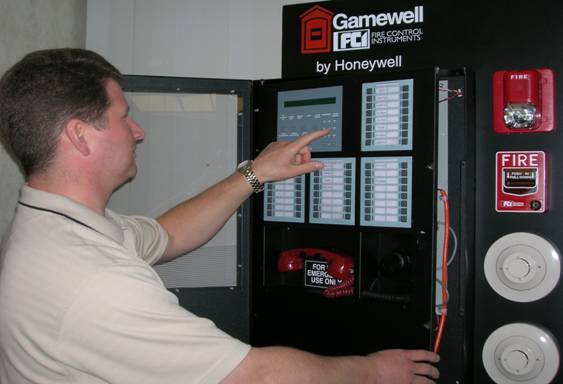Addressable fire alarm
 To enable the source of the alarm to be identified ,each zone must be wired using a separate circuit ,Further more in the event of a fire alarm being triggered, the panel can only identify which zone
To enable the source of the alarm to be identified ,each zone must be wired using a separate circuit ,Further more in the event of a fire alarm being triggered, the panel can only identify which zone
contains the triggered device, it is then necessary to manually search the affected zone to discover the actual cause of the alarm.
Intelligent addressable systems overcome these limitations, each fire detecting sensor or callpoint is electronically coded with a unique identification or ‘address’ which is programmed into the device during installation. The control panel is then able to conduct two way communication with any of the addressable devices connected to the system by using the unique address number to define which device it wishes to communicate with. This operates in a similar manner to that of a telephone number enabling Communication between specific telephones.
 Under normal conditions the control panel continuously interrogates each device in sequence using a low power digitally pulsed signal, and analyses the reply to determine the status of the sensor or call point In this manner, the panel can ascertain whether each device is functioning correctly and also discover the amount of smoke or heat that the device is currently sensing.
Under normal conditions the control panel continuously interrogates each device in sequence using a low power digitally pulsed signal, and analyses the reply to determine the status of the sensor or call point In this manner, the panel can ascertain whether each device is functioning correctly and also discover the amount of smoke or heat that the device is currently sensing.
This technology allows the panel to make intelligent decisions as to the appropriate action to take based on the information it receives from the individual Sensors .
This has many advantages, for example very slow build up of apparent smoke density seen by a sensor can cause a warning or pre alarm condition to be triggered by the alarm panel prior to the situation becoming serious enough to warrant a full alarm.
A typical practical benefit of this technology is the situation whereby airborne dust particles enter smoke detectors and mimic the appearance of smoke, over time the concentration of dust can increase to a point where it can cause the detector to falsely trigger an alarm condition.
With an intelligent addressable System, a pre alarm condition will normally be triggered rather than a full alarm giving the building operator the opportunity to clean or replace the sensor rather than suffer the disruption of an unwanted false alarm. If whilst continually interrogating the smoke and heat sensors, the panel determines that the data gathered from a specific device is appropriate to instigate either a fire, fault or pre alarm condition, it uses the unique identifying number or address to determine which device is involved.
a pre alarm condition will normally be triggered rather than a full alarm giving the building operator the opportunity to clean or replace the sensor rather than suffer the disruption of an unwanted false alarm. If whilst continually interrogating the smoke and heat sensors, the panel determines that the data gathered from a specific device is appropriate to instigate either a fire, fault or pre alarm condition, it uses the unique identifying number or address to determine which device is involved.
Consequently the panel can pinpoint and identify precisely which device has triggered the fire, fault or pre alarm condition.
This level of sophistication removes the need for each zone of the building to be wired as a separate circuit.
For this reason intelligent addressable system components are typically connected to the panel using a small number of large loops thus greatly simplifying the installation of the system and reducing the installation cost.
Detectors instead of being simple two state devices now function as sensors continually communicating with the control panel and providing information regarding the temperature or concentration of smoke in their local environment.






